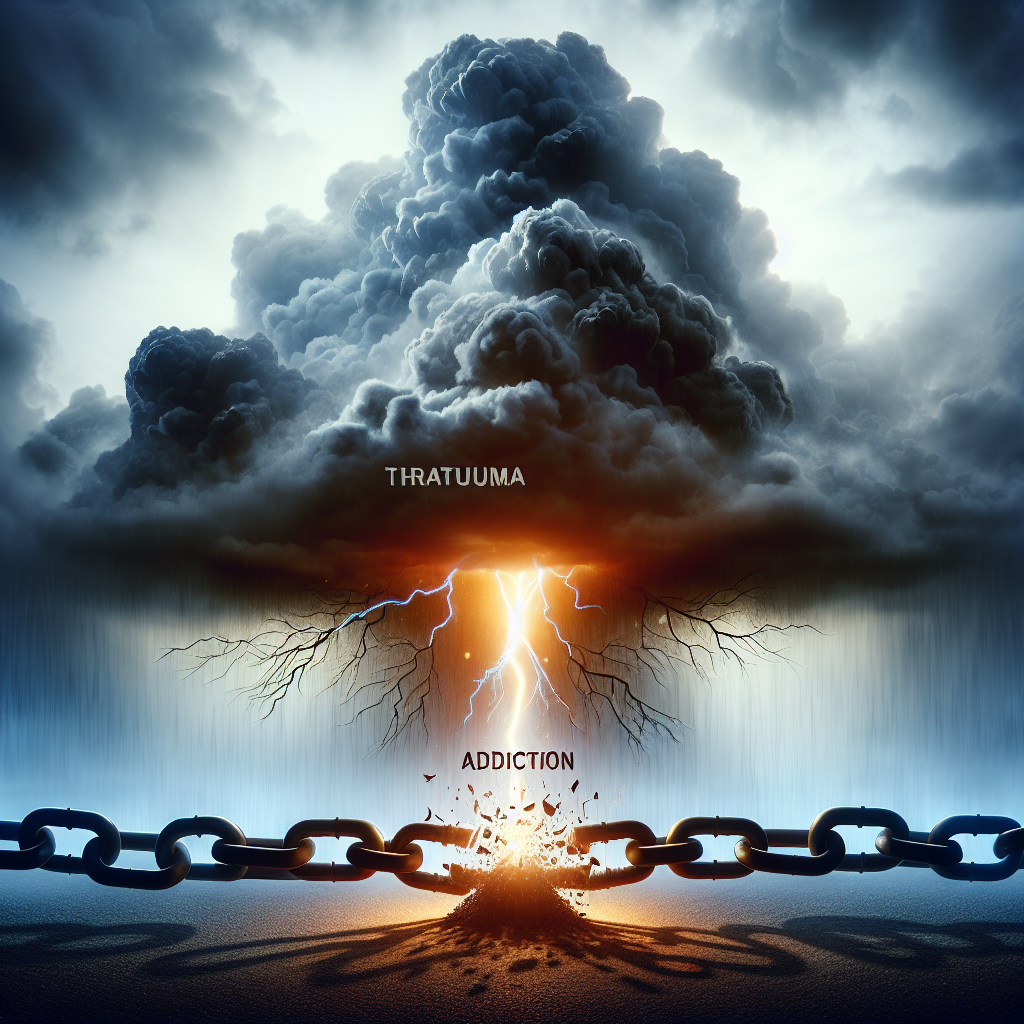-
Table of Contents

“Unraveling the Past: Bridging Trauma and Addiction for a Brighter Future”
Introduction
Understanding the link between trauma and addiction is crucial for developing effective treatment strategies and fostering long-term recovery. Trauma, which can result from experiences such as abuse, neglect, violence, or significant loss, often leaves deep psychological scars. These unresolved emotional wounds can drive individuals to seek relief through substance use, leading to addiction. The interplay between trauma and addiction is complex, involving neurobiological, psychological, and social factors. By exploring this connection, we can better comprehend how traumatic experiences contribute to the development of addictive behaviors and identify comprehensive approaches to support healing and recovery.
Exploring the Psychological Impact of Trauma on Addiction
Understanding the intricate relationship between trauma and addiction requires delving into the psychological impact that traumatic experiences can have on an individual. Trauma, whether stemming from childhood abuse, a severe accident, or witnessing violence, leaves an indelible mark on the psyche. This emotional scarring often manifests in various ways, one of the most concerning being the development of addictive behaviors. To comprehend this connection, it is essential to explore how trauma influences the mind and, subsequently, how it can lead to addiction.
Trauma disrupts the brain’s normal functioning, particularly affecting areas responsible for emotional regulation and stress response. When a person experiences trauma, their brain undergoes significant changes, often resulting in heightened anxiety, depression, and a pervasive sense of fear. These emotional disturbances can be overwhelming, leading individuals to seek relief through external means. Herein lies the crux of the link between trauma and addiction: substances or behaviors that provide temporary relief from emotional pain can quickly become a crutch, leading to dependency.
The cycle of trauma and addiction is perpetuated by the brain’s reward system. When a person uses drugs or alcohol, the brain releases dopamine, a neurotransmitter associated with pleasure and reward. For someone grappling with the aftermath of trauma, this dopamine release can offer a fleeting escape from their emotional turmoil. However, this relief is short-lived, and as the effects of the substance wear off, the individual is often left feeling worse than before. This can create a vicious cycle where the person continually seeks out the substance to recapture that fleeting sense of relief, ultimately leading to addiction.
Moreover, trauma can erode an individual’s self-worth and sense of control, making them more susceptible to addiction. Feelings of powerlessness and low self-esteem are common among trauma survivors, and substances can provide a false sense of empowerment and confidence. This temporary boost can be incredibly alluring, especially for those who feel trapped by their traumatic experiences. Unfortunately, this reliance on substances to feel better about oneself only deepens the cycle of addiction, as the underlying issues remain unaddressed.
It is also important to consider the role of coping mechanisms in the relationship between trauma and addiction. Healthy coping strategies, such as seeking therapy, engaging in physical activity, or building supportive relationships, can help individuals process their trauma and build resilience. However, not everyone has access to these resources or the knowledge to utilize them effectively. In the absence of healthy coping mechanisms, individuals may turn to substances as a way to numb their pain or escape their reality. This maladaptive coping strategy can quickly spiral into addiction, further complicating the individual’s ability to heal from their trauma.
Despite the daunting nature of this cycle, there is hope for those struggling with trauma and addiction. Understanding the psychological impact of trauma is the first step towards breaking free from the grip of addiction. Comprehensive treatment approaches that address both the trauma and the addiction are essential for lasting recovery. This often involves a combination of therapy, support groups, and sometimes medication, all aimed at helping individuals process their trauma, develop healthy coping mechanisms, and rebuild their lives.
In conclusion, the link between trauma and addiction is a complex interplay of psychological factors that can trap individuals in a cycle of pain and dependency. However, with the right support and treatment, it is possible to break this cycle and achieve lasting recovery. By addressing the root causes of trauma and fostering resilience, individuals can reclaim their lives and move towards a future free from the shadows of their past.
Healing Pathways: Integrating Trauma-Informed Care in Addiction Recovery
Understanding the intricate relationship between trauma and addiction is crucial for developing effective recovery strategies. Trauma, often stemming from experiences such as abuse, neglect, or significant loss, can leave deep psychological scars. These scars frequently manifest as emotional pain, which individuals may attempt to numb through substance use. Consequently, addiction can become a coping mechanism, albeit a destructive one, for managing unresolved trauma. Recognizing this connection is the first step toward healing, as it underscores the importance of addressing both trauma and addiction concurrently.
Integrating trauma-informed care into addiction recovery is essential for fostering a holistic healing process. Trauma-informed care acknowledges the widespread impact of trauma and understands potential paths for recovery. It emphasizes safety, trustworthiness, peer support, collaboration, empowerment, and cultural sensitivity. By creating a safe and supportive environment, individuals are more likely to engage in the recovery process and less likely to experience re-traumatization. This approach not only addresses the symptoms of addiction but also the underlying trauma that fuels it.
One of the key components of trauma-informed care is the establishment of a safe and supportive environment. This involves creating a space where individuals feel physically and emotionally secure. Safety can be fostered through consistent routines, clear communication, and the presence of empathetic and non-judgmental staff. When individuals feel safe, they are more likely to open up about their experiences and engage in therapeutic processes. This sense of security is foundational for building trust, which is another critical element of trauma-informed care.
Trustworthiness is cultivated through transparency and consistency. When individuals in recovery can rely on their caregivers to be honest and dependable, it helps to rebuild their capacity for trust, which may have been shattered by traumatic experiences. Trust is further reinforced through peer support, which involves connecting individuals with others who have had similar experiences. Peer support provides a sense of community and shared understanding, which can be incredibly validating and empowering.
Collaboration and empowerment are also central to trauma-informed care. Collaboration involves working together with individuals in recovery to set goals and develop treatment plans. This participatory approach ensures that the individual’s voice is heard and respected, fostering a sense of ownership over their recovery journey. Empowerment, on the other hand, focuses on building individuals’ strengths and resilience. By highlighting their capabilities and encouraging self-efficacy, individuals are more likely to believe in their ability to overcome addiction and heal from trauma.
Cultural sensitivity is another vital aspect of trauma-informed care. It involves recognizing and respecting the diverse backgrounds and experiences of individuals in recovery. This includes being aware of cultural differences in the expression and experience of trauma and addiction. By providing culturally sensitive care, practitioners can ensure that treatment is relevant and respectful, which can enhance engagement and outcomes.
In conclusion, integrating trauma-informed care into addiction recovery is not just beneficial but necessary for holistic healing. By addressing both trauma and addiction, creating a safe and supportive environment, fostering trust, encouraging peer support, promoting collaboration and empowerment, and being culturally sensitive, we can pave the way for more effective and compassionate recovery pathways. This approach not only helps individuals heal from the wounds of their past but also empowers them to build a healthier and more fulfilling future.
Q&A
1. **Question:** How does trauma contribute to the development of addiction?
**Answer:** Trauma can lead to addiction as individuals may use substances as a coping mechanism to numb or escape the emotional pain and distress caused by traumatic experiences. This self-medication can create a cycle of dependency and addiction.
2. **Question:** What are some common types of trauma that can lead to addiction?
**Answer:** Common types of trauma that can lead to addiction include physical or sexual abuse, neglect, witnessing violence, experiencing a natural disaster, and severe emotional or psychological abuse. These traumatic events can significantly impact mental health and increase the risk of substance use disorders.
Conclusion
Understanding the link between trauma and addiction reveals that traumatic experiences can significantly increase the risk of developing substance use disorders. Trauma can lead to emotional pain, stress, and mental health issues, which individuals may attempt to self-medicate with drugs or alcohol. This maladaptive coping mechanism can create a cycle of dependency and further exacerbate both trauma symptoms and addiction. Effective treatment requires addressing both the trauma and the addiction simultaneously, often through integrated therapeutic approaches that include trauma-informed care, counseling, and support systems. Recognizing this connection is crucial for developing comprehensive treatment plans that promote long-term recovery and healing.



